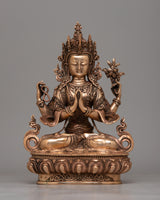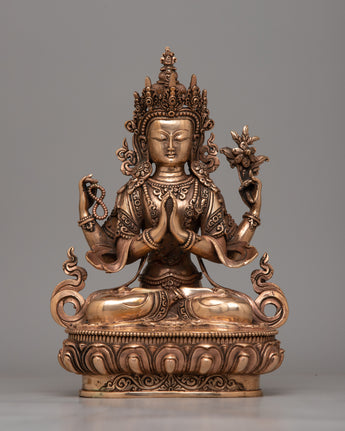
Statue of Chenrezig | Radiating Divine Compassion and Loving-Kindness

100% AUTHENTIC

HANDMADE

FREE SHIPPING
Statue of Chenrezig
About Our Statue :
In the Buddhist tradition, the Statue of Chenrezig, also called Avalokiteshvara, is revered as a source of kindness and knowledge. This statue is carefully handcrafted on a copper body, a material selected for its durability and spiritual importance, with regard and attention to detail. The 24cm-tall monument, which personifies Chenrezig's divine attributes, invites followers to engage with the infinite wisdom and compassion he stands for.
Chenrezig, the embodiment of compassion, is revered by Buddhists all around the world and represents the shared goal of easing the suffering of all living things. A potent reminder of the transformational power of compassion and loving-kindness, the Statue of Chenrezig can be found in meditation spaces, home altars, or temple shrines. This monument encourages followers to practice compassion in their own lives and to work for the well-being of all sentient creatures with its peaceful look and elegant posture.
Introduction To The Chenresig :
Chenresig epitomizes the bodhisattva's determination to delay attaining Buddhahood until he has assisted every sentient being on Earth in achieving freedom from pain and the cycle of death and rebirth. His name has been translated as "the lord who observes in all directions." The practice of Chenresigs encouraged them to develop a calm and compassionate heart. Compassion is the root foundation for excelling in the Buddhist path. He listens to the prayers of all sentient beings in times of challenge and difficulty.
--------------------------------------------------------
Size: 24 cm (Height) x 16 cm (Width)
Weight: 1.89 kg
Materials: Copper
--------------------------------------------------------
How do take care of your statues?
• Place them at room temperature, avoiding direct sunlight.
• Make sure that the area where your statue is placed is completely free of moisture and dust.
• Place it at the highest place on your altar after being consecrated by Lama/monks. The best practice is to keep them covered inside a glass cabinet.
• Do not use your bare hands or any objects with a rough surface to wipe the face. Directly touching with the bare hand objects can smudge the face, leaving scratches.
Shipping & Returns
We ship worldwide. Orders dispatch in 2–3 business days. International delivery typically arrives in 4–10 business days via DHL Express, depending on destination and carrier conditions. All items ship free globally.
Returns are accepted within 14 days of delivery. Products must be returned in original condition for a refund to be issued once received and inspected. Terms and conditions apply.











